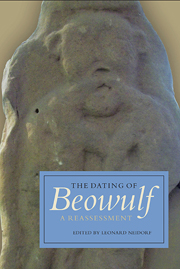Book contents
- Frontmatter
- Contents
- List of Tables
- List of Illustrations
- List of Contributors
- Acknowledgements
- Introduction
- 1 Beowulf and Language History
- 2 Germanic Legend, Scribal Errors, and Cultural Change
- 3 Names in Beowulf and Anglo-Saxon England
- 4 The Limits of Conservative Composition in Old English Poetry
- 5 The Date of Composition of Beowulf and the Evidence of Metrical Evolution
- 6 Beowulf and the Containment of Scyld in the West Saxon Royal Genealogy
- 7 History and Fiction in the Frisian Raid
- 8 ‘Give the People What They Want’: Historiography and Rhetorical History of the Dating of Beowulf Controversy
- 9 A Note on the Other Heorot
- 10 Beowulf and Conversion History
- 11 Material Monsters and Semantic Shifts
- 12 Scandals in Toronto: Kaluza's Law and Transliteration Errors
- 13 Afterword: Beowulf and Everything Else
- Index
9 - A Note on the Other Heorot
Published online by Cambridge University Press: 05 October 2014
- Frontmatter
- Contents
- List of Tables
- List of Illustrations
- List of Contributors
- Acknowledgements
- Introduction
- 1 Beowulf and Language History
- 2 Germanic Legend, Scribal Errors, and Cultural Change
- 3 Names in Beowulf and Anglo-Saxon England
- 4 The Limits of Conservative Composition in Old English Poetry
- 5 The Date of Composition of Beowulf and the Evidence of Metrical Evolution
- 6 Beowulf and the Containment of Scyld in the West Saxon Royal Genealogy
- 7 History and Fiction in the Frisian Raid
- 8 ‘Give the People What They Want’: Historiography and Rhetorical History of the Dating of Beowulf Controversy
- 9 A Note on the Other Heorot
- 10 Beowulf and Conversion History
- 11 Material Monsters and Semantic Shifts
- 12 Scandals in Toronto: Kaluza's Law and Transliteration Errors
- 13 Afterword: Beowulf and Everything Else
- Index
Summary
In a series of papers, Leonard Neidorf has argued that Germanic heroic legend circulated in Anglo-Saxon England predominantly in the seventh and eighth centuries, manifesting itself in Latin testimonia, vernacular poetry, visual art, royal genealogies, and personal names. These papers, together with conversations with their author, gave new impetus and purpose to a note I had been contemplating writing off and on for two or three of decades, a note on the other Heorot.
In two firmly historical passages Bede speaks of a place and a structure, the name of which is built on the word or name Heorot. And as unlikely as it seems, Beowulf scholarship has largely neglected to mention this potentially interesting fact. When I began research for this note, I thought that, against all probability, that neglect had been total; on the whole this initial belief has so far held true, with the unusual nineteenth-century exception of Daniel Henry Haigh, whose views I discuss below, together with brief modern allusions to Haigh. I cannot explain how this second Heorot has escaped the attention of Beowulf scholars – if it really has – and even the brashest scholar would be uneasy about too confidently asserting a negative, especially in such highly cultivated fields as Bede and Beowulf. I will at least affirm that this connection is not noticed in the encyclopedic recent edition of Klaeber or in the older commentaries known to me and so cannot, at the very least, be well known in our field.
- Type
- Chapter
- Information
- The Dating of BeowulfA Reassessment, pp. 178 - 190Publisher: Boydell & BrewerPrint publication year: 2014



